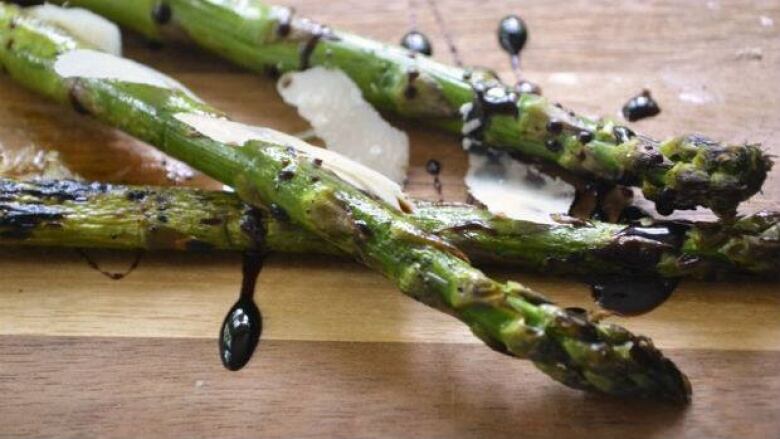How to become a grilled vegetables genius: Andrew Coppolino

Grilling vegetables on an open flame in the great outdoors can complement that pork chop you are barbecuing alongside it, but the vegetables can also fly solo as a delicious centre-of-the-plate ingredient.
There are a few basic principles and techniques to think about when you cook veg on the grill.
Tip 1: The set-up
Like barbecuing a steak or chicken, starting with a clean grill is important.
- Get the barbecue good and hot and then with tongs holding an old kitchen towel soaked in vegetable oil, wipe the hot grills clean before adding any food.
Tip 2:Watch the heat
When it's time to grill, it's important to remember that vegetables are mostly water. This makesthe thermodynamics different than grilling a dense piece of muscle where the dry heat removes moisture from the vegetable quickly. On the one hand, that can concentrate and intensify flavour; on the other, the sequence from dry to brown to completely burned crisp can be a quick one.
- Stay with your food and watch it carefully. If possible, make sure that there is a greater distance between the flame and veg than there would be for meat, and that the heat is lower and that any slices of vegetable are a bit thicker.

Tip 3: Bring on the flavour
Whether it is propane or a charcoal barbecue, create a good grilling environment with direct heat on one side and indirect heat on the other.
- Note that grilling corn-on-the-cob in its husk or wrapping foods in a tin foil pouch, at least to start off, can help reduce charring. That said, getting a bit of char on those vegetables caramelization takes place when sugars start to turn brown at about 330-degrees F can mean a lot of added flavour.
Grilled salads
By following a few basics, you can grill just about any vegetable, including lettuce. Take a head of Romaine for instance, slice it in quarters, add oil and salt and pepper and grill it lightly for a few minutes. This can then be an old-school "wedge" salad with the type of dressing you desire. It could also become a deconstructed Caesar salad with the creamy dressing and a grilled slice of bread as a crouton.
Cabbage can be cut and grilled in a similar method for 15 minutes or so and thinly sliced and tossed together with your favourite dressing to make a charred coleslaw. It's the same with bitter greens like radicchio, endive and rapini: low and slow grilling adds a brown char and a layer of flavour to the leaves which can be eaten with salt and pepper or added to a salad.

Vegetable variety
Asparagus needs only to be washed, dried, oiled, seasoned and grilled to light brown to be perfect. Remove the thinner pieces as they are done so as not to overcook them. Cut some Brussels sprouts and blanch them before oiling and seasoning and cook them on a moderately hot grill.
Slice the top off of a head of garlic, drizzle with good olive oil and salt and pepper, wrap in foil and roast in the back corner of the barbecue for 45 minutes or until soft. Squeeze out the cooked garlic paste, and it makes a delicious spread to have with the grilled bread and Caesar salad.
As for other alliumslikefresh green onions and scallionsthose can be grilled whole and on the barbecue's cooler side before moving them to the hot side for caramelization. It's the same with leeks that are halved, washed, dried, oiled, seasoned and grilled. Red onions cut like orange segments with the root end kept intact and then seasoned and oiled grill nicely on moderate heat as well.
Root veg like beets have a lot of stored sugars and do really well either cut in quarters, oiled and seasoned before being wrapped in foil and barbecued, or sliced, oiled and grilled low and slow to develop flavour. Carrots sliced on the bias and grilled readily accept a good honey-based glazing with their slight char.

Ratatouille, cheese, tomatoes
Take a classic Provenal dish, ratatouille, and give its elements a grilling: you will be amazed at the added depth of flavour in peppers, onions, eggplant, zucchini, garlic, herbs and olive oil. It can be eaten warm or cooked ahead and served at room temperature (just don't cook the veg too long or they will be too soft later).
Cheeses like halloumi, paneer and kefalotyri can be oiled and grilled: add the cheese cubes to vegetable skewers. Or, toss a water-soaked cedar plank on the grill and let a Camembert soften and warm up for digging into and slathering on to grilled bread with herbs.
Finally, when summer tomatoes make it to the market, it's our chance to savour a taste of the sun. Eat them up as they are, but set aside a few and make a smokey, barbecued tomato oil as a salad dressing.
Slice a half-dozen tomatoes in half, coat in oil, add salt and pepper. Grill until they are soft. Cool (you can remove the seeds and skins if you like) and then put the tomatoes into a food processor and whiz them up.
Carefully add amounts of olive oil, chopped onion or shallot, some vinegar, some herbs, some Worcestershire sauce and a dollop of mustard of your choice and to taste. Whiz the ingredients together, taste and adjust with salt and pepper to your liking. Drizzle on those grilled Romaine wedges and enjoy the flavour of summer.
More food stories from CBC Kitchener-Waterloo columnist Andrew Coppolino












_(720p).jpg)


 OFFICIAL HD MUSIC VIDEO.jpg)
.jpg)



























































































